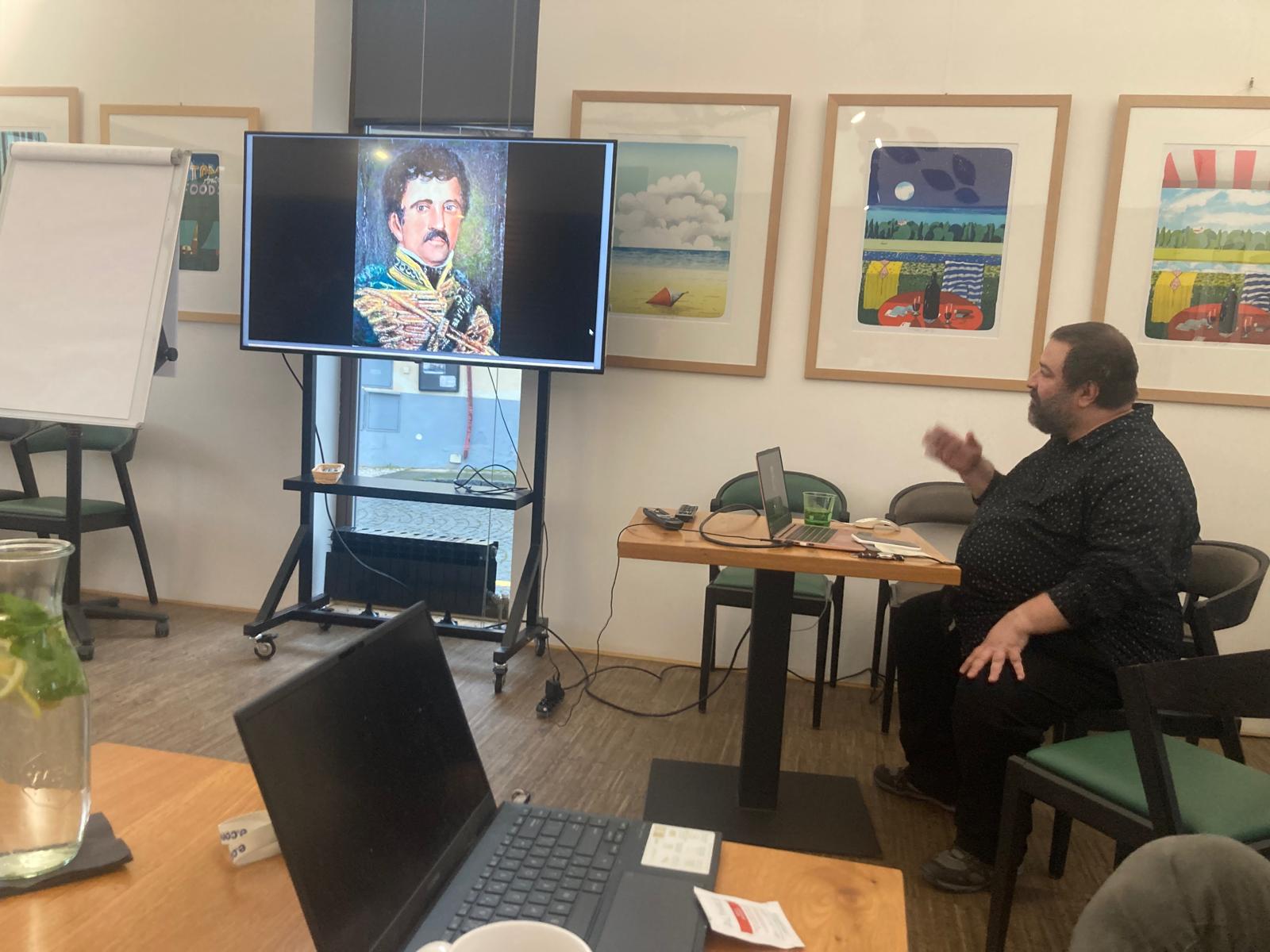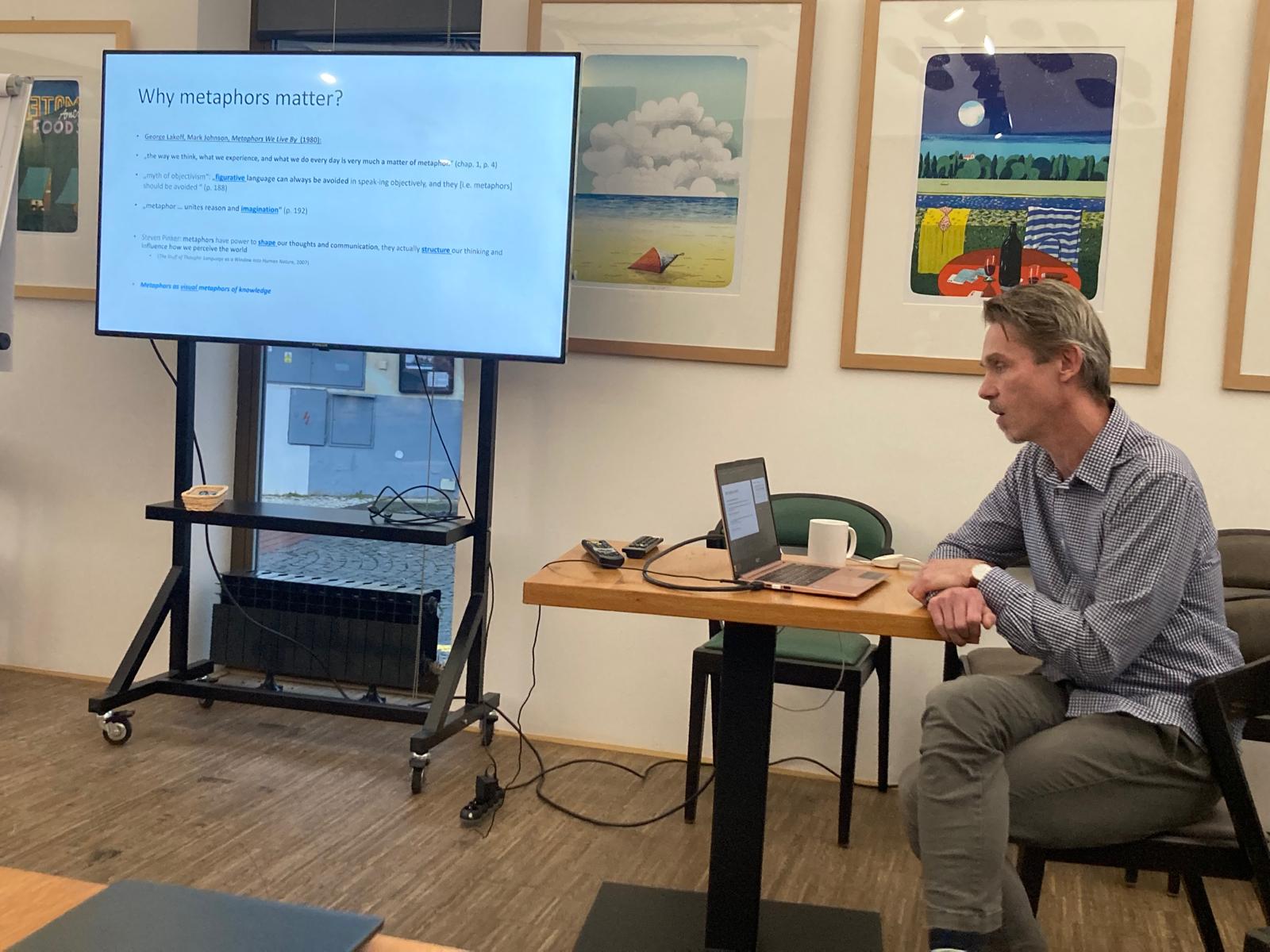From October 2–4, 2024, TOME’s second team school took place in the picturesque town of Dobřichovice at the Panská zahrada venue. This event brought together participants from all of TOME’s research groups, creating an opportunity to collaborate, share knowledge, and strengthen team bonds.
The program featured a mix of interactive workshops, group discussions, and team-building activities. These sessions were designed to foster collaboration, inspire innovation, and underline the importance of shared learning in advancing TOME’s research objectives.
TOME’s 2nd team school was attended by: Alessandro Nannini, Alexander Huber (online), Jan Tvrz, Jana Ředinová, Jana Švadlenková, Jindra Kubíčková, Jo Hedesan, Lenka Řezníková, Lucie Storchová, Marcela Slavíková, Martin Žemla, Márton Szentpéteri, Ondřej Kříž, Petr Pavlas, Vojtěch Kaše, Vladimír Urbánek (guest).

Here you can find summaries of the talks presented over the three days of the School.
DAY 1 – Intellectual-historical Group
- Petr Pavlas – Evolution of Metaphors as a History of Cultural Ideas. The Case of the Circle/Sphere Metaphor before 1630
Petr introduced a theoretical framework for studying the evolution of metaphors and traced the cognitively significant uses of circle, cycle, and sphere metaphors from antiquity up to 1630, marked by the publication of Alsted’s Encyclopaedia septem tomis distincta.
- Lucie Storchová – Metaphors of the human heart and their epistemological shifts after 1600: A case study in Protestant discourses of power
Lucie examined the metaphor of the heart in 16th- and 17th-century political and social discourse. She discussed its centrality as a symbol of cooperation within the “social body” and explored its disciplinary function in hierarchical metaphors. Lucie highlighted shifts from Melanchthonian providentialism to Paracelsian-spiritualist mysticism around 1610, where political heart metaphors declined, and astronomical metaphors like the heart as the Sun gained prominence, advocating heliocentrism.
- Lenka Řezníková – Metaphors of Harmony in Comenius and in Early Modern Science
„Mersenne accomplished the harmonization of mechanics through the mechanization of music.“ (Peter Dear)
Lenka analyzed the tension between musical and mathematical-mechanical notions of harmony in early modern thought. For Comenius, harmony signified both a mechanical order and a holistic congruence, oscillating between metaphors for knowledge, education, and encyclopedias. She explored the metaphor’s dual usage, emphasizing its broader implications in early modern intellectual contexts.
- Marcela Slavíková – Metaphors of Music in Comenius and in Early Modern Science
Marcela presented her analysis of musical metaphors in Comenius’s works and other early modern sources, including databases like Comenius Opera Omnia and NOSCEMUS. She argued that musical metaphors were not always directly tied to knowledge but often carried rhetorical or biblical significance, as seen in works like Bazuine des genaden jaar(1632) and Letzte Posaun über Deutschland.
- Alessandro Nannini – Georgics of the Soul: Agriculture as Cultivation of the Self
in the Early Modern Age
Alessandro traced the metaphor of the “georgics of the soul” from antiquity through early modernity. Drawing on Cicero, Seneca, Augustine, and Bacon, he explored its ethical dimensions, showing how thinkers like Wesenfeld, Pufendorf, and Baumgarten developed the concept into frameworks for both individual and collective cultivation. He linked this tradition to the broader history of care for the soul, resonating with Jan Patočka’s philosophical narratives.
- Márton Szentpéteri – King Solomon in Transylvania: Miklós Bethlen and his Castle
Márton expanded metaphor studies to include spatial metaphors in architecture, citing John B. Onians’s theories. He examined Miklós Bethlen’s Transylvanian castle (1667–1683), influenced by Nicolaus Goldmann and Villapando’s reconstruction of Solomon’s Temple. Márton argued that Bethlen’s self-fashioning echoed young King Solomon’s wisdom, contrasting with his later autobiographical reflections on the vanity of architecture.
- Martin Žemla – See, Hear, Taste. Sensory Metaphors in 16th and 17th Century
Paracelsianism
Martin presented a comprehensive historical overview of sensory metaphors in European philosophical, theological, and mystical traditions, with a focus on Paracelsianism. He analyzed the challenges of classifying taste metaphors as metaphors of knowledge, contrasting them with the traditionally exemplary visual metaphors, and highlighted their complex roles in knowledge frameworks of the era.



II. DAY 2 – Computational-historical Group
- Vojtěch Kaše – Computing Noscemus: a practical workshop in Python (1) & (2)
In the first part of his workshop, Vojtěch introduced participants to the TOME project’s coding environment, which now relies on the cloud computing services provided by CCS-Lab. He guided attendees through scripts used for generating, analyzing, and visualizing static word embeddings trained on the NOSCEMUS corpus. In the afternoon session, Vojtěch delved into the project’s current work with contextual Latin embeddings based on Latin BERT, exploring their potential for metaphor detection. See videos from the workshop here and here.
- Jana Švadlenková – Cognitive & computational approaches to metaphors: an overview
Jana provided a compelling overview of the history and systematics of Cognitive/Conceptual Metaphor Theory (CMT). She shared examples of practical applications—such as mapping one conceptual domain to another—and highlighted theoretical challenges within CMT, including metaphorical blending and blended mental spaces. One key message from Jana’s talk was that metaphors are challenging not only for machines but also for humans. This led to a discussion about the need for benchmarking to validate the effectiveness of an AI-powered metaphor detector for early modern texts.
- Jan Tvrz – Contextual word embeddings and metaphor detection
Jan explained how contextual word embeddings work, how they are generated, and how they relate to the challenge of metaphor detection. Unlike static embeddings (e.g., Word2Vec), dynamic contextual word embeddings capture the context in which a word (or token) appears, alongside the specific meaning of that word-token. This is akin to the later theories of Wittgenstein’s philosophy of language. Jan emphasized that for effective metaphor detection, a combination of both static and dynamic embeddings is necessary. He demonstrated how metaphor detection works in English corpora using the BERT model, and discussed TOME’s current efforts to adapt this approach for the NOSCEMUS corpus of early modern scientific Latin using Latin BERT. For more information, see Vojtěch’s videos linked above.


III. DAY 3 – Digital-philological Group
- Jo Hedesan – Objectives, Approaches and Results of the Transcription Team & Transkribus training
Jo introduced the objectives of her group: transcribing the printed Latin alchemical corpus from around 1500 to 1600 (Corpus TOME A), and from 1601 to circa 1700 (Corpus TOME B). By the end of the first year, the group had transcribed a highly curated sample of 16th-century alchemy, comprising a catalogue of 140 works, with approximately 70 works transcribed to date.
Jo presented two definitions of alchemy: a narrow one, and a broader, more tentative definition, which was employed for compiling the catalogue of Corpus TOME A. She also introduced the members of her group and outlined the transcription pipeline, standards, and procedures they follow. Furthermore, Jo discussed the Transkribus recognition model TOME 2.1, which she is currently working on and training to improve the transcription process.


Conclusion
The TOME 2nd Team School in Dobřichovice was a wonderful event that fostered collaboration, knowledge-sharing, and innovative approaches across its diverse research groups. Over the three days, participants explored a range of intellectual and computational topics, enriching the collective understanding of early modern metaphors, computational methods, and transcription challenges. The interactive format of workshops, discussions, and presentations created a dynamic environment for both individual growth and team cohesion.
The event not only highlighted the interdisciplinary potential within the TOME project but also reaffirmed the importance of teamwork in addressing complex academic challenges. With the valuable insights gained and the connections strengthened, the team is now better equipped to advance its research goals in the months ahead.



Leave a Reply